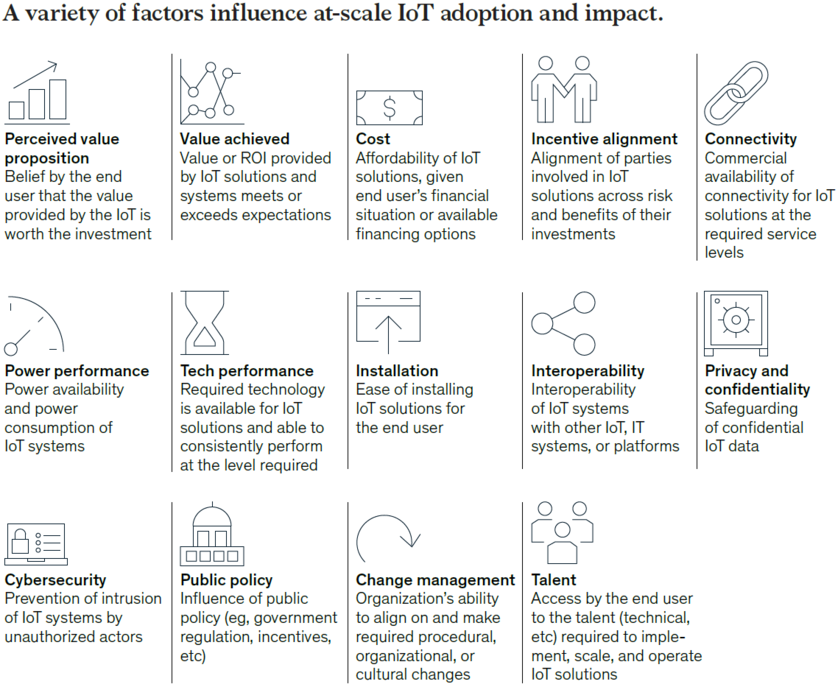แทบไม่น่าเชื่อว่า IoT ที่รู้จักกันในปัจจุบัน ได้วิวัติขึ้นจากหัวข้อสนทนาเฉพาะกลุ่มเล็กที่กระจายอยู่ตามหน่วยงานต่าง มองไปรอบตัว นับตั้งแต่อุปกรณ์วัดสัญญาณชีพที่เราสวมใส่ เทอร์โมสแตทอัจฉริยะในครัวเรือน ระบบจัดการบริหารยานพาหนะที่แจ้งตำแหน่งพัสดุ ไปจนถึงระบบตรวจสอบคุณภาพอากาศหายใจ กล่าวได้ว่า IoT ทำให้เรามีวิถีชีวิตอย่างที่เป็นอยู่ในปัจจุบัน และคงไว้ซึ่งความร้อนแรงโดยตัวเทคโนโลยีของมันเอง อีกทั้งหลากหลายผลิตภัณฑ์ได้คิดค้นพัฒนาและทยอยพากันเปิดตัว โดยคาดว่าจำนวนอุปกรณ์ IoT จะมีจำนวนสูงถึง 14.5 พันล้านเครื่องทั่วโลกเมื่อสิ้นปี 2022

Source: GlobalData, Thematic Research
รายงานของจาก GlobalData บ่งชี้ว่าตลาด IoT l จะทำกำไรมหาศาลมูลค่ากว่า 1.1 ล้านล้านดอลลาร์ภายในปี 2024 โดยที่อุปกรณ์สวมใส่จะเติบโตแรงที่สุด ส่วนตลาด IoT ทั่วทั้งโลกจะมีมูลค่า 622 พันล้านดอลลาร์เมื่อจบปี 2022 เพิ่มขึ้นจาก 586 พันล้านดอลลาร์ในปี 2019 และจะเติบโตไปถึง 1,077 พันล้านดอลลาร์ภายในปี 2024 ด้วยอัตราการเติบโตต่อปี (CAGR) 13% ในช่วงเวลาดังกล่าว ตามการคาดการณ์ของ GlobalData IoT ระดับองค์กรครองตลาด IoT โดยรวม โดยสร้างรายได้ 76% ในปี 2020 การครอบงำของ IoT ระดับองค์กรนี้จะดำเนินต่อไปในอนาคตอันใกล้

Source: GlobalData, Thematic Research
ส่วนตลาด IoT ระดับองค์กรเติบโต 22.4% นับเป็นมูลค่า 157.9 พันล้านดอลลาร์ในปี 2021 ตามผลการวิเคราะห์ของ IoT Enterprise Spending Dashboard แต่จากปัจจัยหลายประการ ส่งผลให้ตลาดจึงเติบโตช้ากว่าที่คาดการณ์ไว้ 24% รวมถึงการฟื้นตัวของเศรษฐกิจโดยรวมที่ช้ากว่าที่คาดการณ์ไว้ ภาวะขาดแคลนชิปเซ็ต และการชะงักงันในห่วงโซ่อุปทาน อย่างไรก็ดี อเมริกาเหนือเป็นภูมิภาคที่เติบโตเร็วที่สุดในปี 2021 (+24.1%) โดยที่เติบโตเร็วที่สุดคือเซกเมนต์ทีเกี่ยวข้องกับกระบวนการทางการผลิต (+25%)

Source: IoT Analytics
รายงานจาก IoT Analytics ได้คาดการณ์ว่าตลาดไอทีจะเติบโตที่ CAGR 22.0% จาก 2022 ถึง 2027 เป็น 525 พันล้านดอลลาร์ หากแต่ว่าอุปสรรคต่อการเติบโตหลายครั้งส่งผลกระทบอย่างลึกซึ้งมากกว่าที่คาดการณ์ไว้ก็คือการขาดแคลนแรงงาน ข้อมูลเชิงลึกจากรายงานยังได้บ่งชี้อีกด้วยว่าเมกะเทรนด์ทางเศรษฐศาสตร์อันทรงอิทธิพล ที่ขวางวิถีการเติบโตของ IoT อย่างจัง คือ ปัจจัยทางการเมือง สิ่งแวดล้อม และความก้าวหน้าทางเทคโนโลยี

Source: IoT Analytics
หนึ่งในตัวอย่างการนำเทคโนลีดิจิทัลและ IoT มาใช้งานจนเป็นผลสำเร็จคือ Moderna เป็นที่ประจักษ์ต่ออุตสาหกรรมยา ถึงความสำคัญของการมุ่งมั่นทางดิจิทัล โดยโรงงานอัจฉริยะของ Moderna ได้รับบทดสอบจาก COVID-19 ในเดือนกรกฎาคม 2020 และได้กลายเป็นบริษัทแรกๆ ในอเมริกาที่สามารถเข้าสู่การทดลองทางคลินิกสำหรับวัคซีนต้านไวรัสโคโรน่าระยะที่ 3 โดยใช้เวลาเพียงไม่กี่เดือนหลังจากข้อมูลพันธุกรรมของไวรัสดังกล่าวถูกถอดรหัส
ด้วยอัตราการยอมรับเทคโนโลยีใหม่ที่สูงขึ้น ส่งผลให้เอเชียแปซิฟิกเป็นตลาดอุตสาหกรรมไอที่คึกคักมากที่สุด โดยภูมิภาคเอเชียแปซิฟิก ประกอบด้วยประเทศเศรษฐกิจเกิดใหม่และประเทศพัฒนาแล้วหลายแห่ง เช่น ออสเตรเลีย อินเดีย จีน ญี่ปุ่น และสิงคโปร์ และคาดว่าตลาด IoT ในเอเชียแปซิฟิกจะเติบโตถึงขีดสุด ภูมิภาคนี้ยังมีพลวัตของขยายตัวของเมืองมากสูงที่สุดในโลกอีกด้วย

Source: Moderna

Source: IoT Analytics
แม้ว่า IoT จะทำให้เกิดโอกาสทางธุรกิจอย่างมหาศาล แต่ก็นำมาซึ่งผลพวงในแง่มุมของการพัฒนาที่ยั่งยืน ตัวอย่างเช่น ประเทศญี่ปุ่นได้ประกาศความสำเร็จของ “โครงการเมืองอัจฉริยะ” แล้วก็ตามแต่ประเทศอื่นในภูมิภาคเดียวกันยังเพิ่งจะเริ่มต้น สำหรับประเทศจีนนั้นถือว่าเป็นตลาด IoT เพื่องานเมืองอัจฉริยะที่ใหญ่ที่สุด ส่วนในประเทศอินเดียเองก็ผุดโปรเจคเมืองนวัตกรรมมากกว่า 5,000 โครงการ รวมมูลค่าการลงทุนแล้วกว่า 2 ล้านล้านรูเปียซึ่ง แต่ละโครงการมีอัตราความก้าวหน้าแตกต่างกันไป จะเห็นได้ว่าประเทศมีการพัฒนาทางเทคโนโลยีไปถึงขั้นสุด ในขณะที่บางประเทศยังลังเลที่จะนำเทคโนโลยีมาใช้ ทั้งนี้คาดว่าการขาดความรู้ความเชี่ยวชาญในหมู่ผู้ใช้ปลายน้ำและทรัพยากรโครงสร้างพื้นฐานในประเทศกำลังพัฒนา จะเป็นปัจจัยจำกัดการเติบโตของตลาด IoT ในเอเชียแปซิฟิก

Source: Mordor Intelligence

A variety of factors influence at-scale IoT adoption and impact.
Source: The Internet of Things: Catching up on an accelerating opportunity, McKinsey & Company
Article by: Asst. Prof. Suwan Juntiwasarakij, Ph.D., Senior Editor & MEGA Tech












